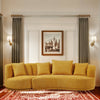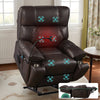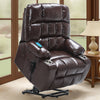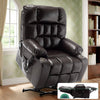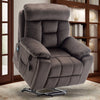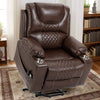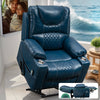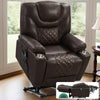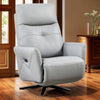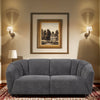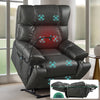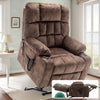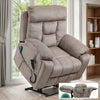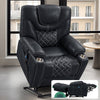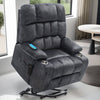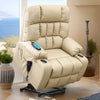The Importance of Power Lifting Assistance for the Elderly
Understanding the Need for Enhanced Mobility
As we age, mobility becomes a key concern. Many seniors face challenges with everyday tasks. Getting up from a chair can be a struggle. This is where power lifting chairs come in. They offer a helping hand to the elderly.

These chairs are more than just furniture. They are tools for independence. With a push of a button, seniors can stand up or sit down safely. This simple act can make a big difference in their lives.
Power lifting chairs address a real need. They help prevent falls, which are a major risk for older adults. By providing support, these chairs allow seniors to move with confidence. This enhanced mobility is crucial for aging in place.
The Impact of Power Lifting on Quality of Life
Power lifting chairs can greatly improve the quality of life for seniors. They offer more than just physical support. These chairs provide a sense of freedom and control. This can boost mental well-being.
With easier movement, seniors can engage more in daily activities. They can join family gatherings or pursue hobbies with less stress. This active lifestyle helps maintain cognitive function and social connections.
The impact extends to caregivers too. Power lifting chairs reduce the physical strain of assisting seniors. This leads to better care and less caregiver burnout. Overall, these chairs create a positive ripple effect in seniors' lives.
Key Features to Look for in Power Lifting Chairs
Ergonomic Design and Comfort
When choosing a power lifting chair, comfort is key. Look for chairs with ergonomic designs. These should support the body's natural curves. Good lumbar support is essential for reducing back pain.

Many high-end recliners offer customizable comfort features. These may include:
- Adjustable headrests
- Multiple reclining positions
- Heat and massage functions
The upholstery material matters too. Soft, breathable fabrics can enhance comfort. Some chairs even have cooling gel-infused foam for temperature control. Remember, a comfortable chair encourages regular use and better posture.
Safety and Ease of Use
Safety is a top priority in power lifting chairs. Look for models with smooth, steady lift mechanisms. These should operate at a comfortable speed. Anti-tip designs add an extra layer of security.
Easy-to-use controls are crucial. Large, clearly marked buttons help seniors with limited dexterity. Some chairs offer remote controls or even smartphone apps for operation. Battery backup systems ensure the chair works during power outages.
Other safety features to consider include:
- Non-slip upholstery
- Locking mechanisms in different positions
- Side pockets for keeping essentials close
These features combine to create a safe, user-friendly experience for seniors.
Customization Options for Different User Needs
Every senior has unique needs. The best power lifting chairs offer customization options. Adjustable seat height and depth can accommodate different body types. Some chairs have interchangeable arm and headrest covers.
For those with specific health concerns, look for chairs with:
- Zero-gravity positions for circulation
- Lift angles suitable for hip or knee issues
- Dual motors for independent back and footrest control
Some high-end models even offer memory settings. These can store preferred positions for different users or activities. The goal is to find a chair that adapts to the user, not the other way around.
Implementing Power Lifting Chairs in Care Facilities
Best Practices for Integration into Existing Services
Integrating power lifting chairs into care facilities requires careful planning. Start by assessing the needs of residents. Consider the layout of common areas and individual rooms. This helps determine the best placement for the chairs.

Create a phased implementation plan. Start with a few chairs in high-traffic areas. This allows staff and residents to adjust gradually. Gather feedback and make improvements before full-scale implementation.
Consider these best practices:
- Ensure proper electrical outlets are available
- Allow space for chair movement and user transfer
- Place chairs in areas that promote socialization
Regular maintenance checks are crucial. Set up a schedule for cleaning and servicing the chairs. This prolongs their life and ensures they remain safe to use.
Training Staff on the Benefits and Use of Power Lifting Chairs
Proper staff training is key to successful implementation. All staff should understand the benefits of power lifting chairs. This includes not just caregivers, but also administrative and maintenance staff.
Training should cover:
- How to operate the chairs safely
- Proper transfer techniques for residents
- Basic troubleshooting and maintenance
Hands-on practice sessions are essential. Staff should feel comfortable using the chairs before assisting residents. Consider creating quick-reference guides for common functions and issues.
Emphasize the positive impact on resident independence. This helps staff see the chairs as valuable tools, not extra work. Regular refresher courses can keep everyone up-to-date on best practices.
Case Studies: Successful Implementations in the United States
Several care facilities in the U.S. have successfully integrated power lifting chairs. One example is Sunshine Retirement Living in Florida. They introduced these chairs in their common areas. Residents reported increased mobility and social engagement.
Another case is Green Acres Nursing Home in Texas. They provided power lifting chairs in all resident rooms. This led to a 30% reduction in fall-related injuries over six months. Staff also reported less physical strain when assisting residents.
The Village at Rockville in Maryland took a different approach. They created a "try before you buy" program. Residents could test different chair models before choosing one. This personalized approach increased satisfaction and usage rates.
These case studies show the positive impact of power lifting chairs. They highlight the importance of tailored implementation strategies. By learning from these successes, other facilities can improve their own integration processes.







